RARE ORIGINAL Dealer Store Catalog Kilgore Toy Cap Guns 1954 Roy Rogers etc
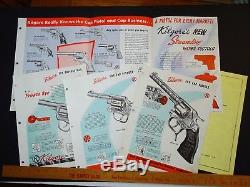
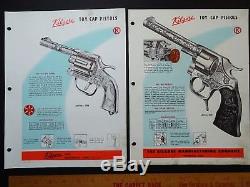
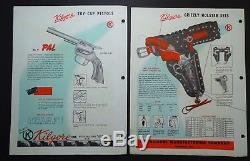
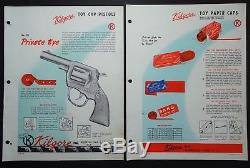
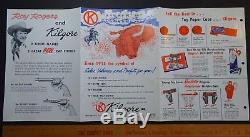
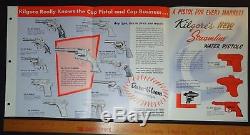
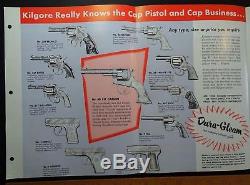
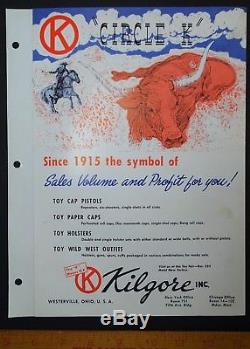
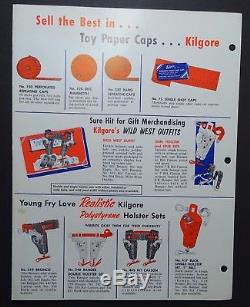
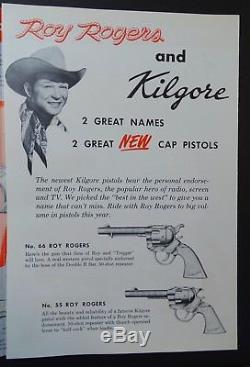
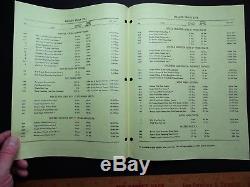
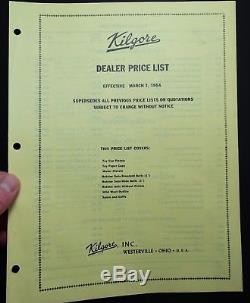


SUPER RARE Advertising Catalog & Inserts. DEALER - STORE Wholesale Catalog. For offer, a nice old trade catalog. Fresh from an estate in Upstate New York. Never offered on the market until now.
Vintage, Old, antique, Original - NOT a Reproduction - Guaranteed!! Very nice - catalog / large flyer with insert sheets and price list. Came from an old estate near Rochester, NY - I will be listing other catalogs from this estate. I Wish I Could have gotten the guns but someone else got them before I could get them. Toy Cap Pistols, paper caps, holsters, wild west outfits. Circle K - Roy Rogers, Kit Carson, Bronco, Eagle, Big Horn, Bobcat, Mountie, Ranger, Private Eye, Grizzly, Buck, Pal, Hawkeye Young Fry Love, double holster sets, etc.Also streamline water pistols - pocket squirt gun, space squirt, and western. A couple of the inserts are two-sided.
All pieces shown in photos. In very good condition - holes punched in left side edge.
Light soiling to a few pages. Please see photos for details. If you collect Americana history, American advertisement ad, diecast / cast toys, etc. This is one you will not see again soon. A nice piece for your paper / ephemera collection.Perhaps some genealogy research information as well. A cap gun, cap pistol, or cap rifle is a toy gun that creates a loud sound simulating a gunshot and a puff of smoke when a small percussion cap is exploded. Cap guns were originally made of cast iron, but after World War II were made of zinc alloy, and most newer models are made of plastic.
Cap guns get their name from the small discs of shock-sensitive explosive compounds roughly 1.4 to 1.6 millimetres (0.055 to 0.063 in) in diameter that provide the noise and smoke, effectively the same as the Maynard tape primer and percussion caps used in real firearms of the mid to late 1800s but usually smaller and made from cheap plastic or paper. Some are arranged in plastic rings of eight or twelve. There are also single caps, roll caps (of 50 to 500), disk caps, and cap strips all of which are actually extremely small versions of percussion fireworks.
Armstrong's mixture is often used today as the explosive, but previously the tiny powder charge was a simple mixture of potassium perchlorate, sulfur, and antimony sulfide sandwiched between two paper layers which hold in the gases long enough to give a sound report when the cap is struck. Cap guns first appeared following the end of the American Civil War in the mid-1860s, when firearms companies experimented with toy guns in order to stay in business. Cap guns became especially popular when the heroes of cinema and television rode through the West ridding the territories of villains. Many cap guns were named after or endorsed by leading matinee idols like Roy Rogers, Gene Autry, Hopalong Cassidy, The Lone Ranger, Tonto, Dale Evans, Marshal Matt Dillon, or any of countless others.
A display of Nichols Industries cap guns. Some collectors collect all brands. The "Golden Age" of cap guns was roughly a 20-year period following World War II when television became popular and such companies as Nichols, Hubley, Kenton, Kilgore, Wyandotte, Classy, Mattel, Actoy, Esquire, George Schmidt, and Stevens in the USA and companies like Lone Star Toys in the UK made millions of cap guns in various versions.
While many had their names patterned after a hero or heroine, many cap guns also were named with western-sounding names, like: "Stallion 45", "Pony", "Mustang", "Pioneer", "Cowboy", "Texan", "Colt 45", "Rodeo", and such. Children all over the world emulated their heroes and collected and played with these toy guns.There were many types of cap guns, including guns from small Derringers, to larger rifles, and even working miniatures of most of them. One of the last famous ones to sell widely was a toy rifle named after the television show, The Rifleman, which aired from 1958 through early 1963. Other shows lasted longer, such as Gunsmoke (which had 20 seasons lasting through 1975), but those did not have as much'kid-appeal' as the earlier shows, and the sales of toy cap guns began to decline. The pistols generally were in 3 styles, the semi-automatic, the revolver (that actually had a revolving cylinder carrying a disk of caps) and the mock-revolver that looked like a regular revolver, but opened to load a roll of caps. Almost all of the early models used either roll caps or circular disks of caps, but in 1950 Nichols Industries came out with a large model called the Stallion 45, which had a revolving cylinder into which individual bullets were loaded, which each had two parts.
The circular cap was placed into the 2-piece bullet and then when the gun was loaded and fired, it seemed more realistic. Eventually several companies used this idea and a few years later Nichols invented a plastic bullet that was snapped into a hollowed-out version of the regular 2-piece bullet with a compression spring inside. When the gun was fired, the spring pressure "shot" the plastic pellet out of the end of the barrel. Eventually Mattel also came out with a similar model called Shootin' Shells.Mattel produced an automatic firing cap weapon styled after the Thompson submachine gun. Pulling back on a slide, which simulated the charging handle of the real Thompson, prepared the gun for firing by tensioning a spring.
When the trigger was pulled the spring power would drive the mechanism, firing a series of up to ten caps from a sprocket-fed roll. It was made initially for a Dick Tracy line of toys, then camouflaged for a Green Beret Guerilla Fighter line of weapons, then restyled again as a tie-in with the Planet of the Apes franchise. Greenie Stick-M-Caps: Green peel-and-stick paper caps manufactured by the Mattel company to stick on the back of their "Shootin' Shells". Plastic, red circular discs used today. Containing gunpowder and a zinc alloy used to create a smaller explosion than would be previously reached with pure gunpowder components in the 1950s. Plastic strips, similar to disks, but arranged in a line, often with means of attaching singular strips to one another. Ring cap guns are usually modeled after revolver pistols, with the cap ring placed in the cylinder section of the toy gun. Like its real-world counterpart, when the trigger is pulled, the cylinder rotates a new cap into place, the hammer is drawn back, and then released; the shock causes the cap to explode harmlessly, producing the noise and smoke. Strip or paper cap guns use the aforementioned cap strip in lieu of the cap ring. As in the ring style of gun, each pull of the trigger advances the cap strip forward, pulls back the hammer to the point where it releases, striking the cap. Potato or spud guns occasionally use a cap to provide a burst of gas to fire the projectile, a small cutting of potato. One design employs a small reusable metal "cartridge" which has a recess for a cap at one end and a small drilling through to the other end, which holds the potato. Due to the low energy contained in a paper cap and the poor seal around the cartridge, these spud guns usually have very modest range, barely enough to eject the potato cutting.Mattel introduced a modified type of roll cap that used sprocket feed instead of simple friction feed. A modern cap gun, its barrel made from bright orange plastic to prevent it being mistaken for a real gun. Cap guns and other toy guns in the United States must be manufactured with a bright orange, red, or yellow tip placed over the "muzzle" of the cap gun, or with the entire gun made in these or other bright colours. Laws requiring these markings were made because of incidents where children and teenagers were killed by police officers who mistook cap guns for real guns. While these incidents were rare, lawmakers decided that toy guns must be marked so they cannot be mistaken for real guns.
[2] It is possible to be legally charged with armed robbery while using a replica gun, since no shots need to be fired from a gun that looks real. In July 2008 the U. Consumer Product Safety Commission banned toy caps producing peak sound levels at or above 138 decibels.
[citation needed] Caps that would once have banged and smoked now pop at a low sound level. The purpose of this law is to protect childrens hearing. Caps have occasionally been used in toys other than cap guns where an explosive effect is desired. One example would be the "Thunder Punch" version of the He-Man action figure from the original 1980s Masters of the Universe toy line. Ring caps were placed in a "backpack" integrated into the figure, which contained the striking mechanism for the caps (as well as tiny vents to allow smoke from a triggered cap to escape).This mechanism was triggered by drawing the figure's spring-loaded right arm back and releasing it to swing forward; the explosion of the cap was intended to simulate a thunderous noise caused by the superhuman power of the character's punch. Similar cap firing mechanisms for toy soldiers were produced in Germany for the Elastolin and Lineol toy soldiers and artillery pieces.
Another example is a relatively new type of Airsoft, called Hybrid Guns. Hybrid guns use small round BBs in the tip of a casing, usually designed to mimic that of its respective magazine.
The caps are placed behind the casing. In electric models, the caps are burst, and the pressure is used to propel the BB forward in a manner similar to real firearms. The leftover energy is then sometimes put to use simulating recoil and a blowback system that ejects the casings. Also, caps are used in Chinese toy flare guns. The cap propels one or two pyrotechnic star loads in flare cartridge (firearms). Another use is in so-called "cap bombs"; devices roughly in the shape of an aerial bomb that contain a firing mechanism in the nose capable of holding a single cap, either plastic or paper (cut from a strip), though types are not interchangeable due to the mutually exclusive design. With the newer designs they have both the paper cap or plastic cap. When dropped on a hard surface, the impact detonates the cap. Another use is in "exploding pens" which are devices that look like ink pens but these contain an anvil where the explosive cap is placed, then a spring-loaded lever is pulled back and held in place by the cap of the pen. The pen is then ready to leave around or given to another person as a practical joke. When an unsuspecting person pulls the cap of the pen off, the spring drives the lever against the explosive cap for a surprise bang. Roy Rogers (born Leonard Franklin Slye, November 5, 1911 July 6, 1998) was an American singer and actor. He was one of the most popular Western stars of his era. Known as the "King of the Cowboys", [1] he appeared in over 100 films and numerous radio and television episodes of The Roy Rogers Show. In many of his films and television episodes, he appeared with his wife, Dale Evans; his golden palomino, Trigger; and his German shepherd dog, Bullet.His show was broadcast on radio for nine years and then on television from 1951 through 1957. His productions usually featured a sidekick, often Pat Brady, Andy Devine, George "Gabby" Hayes, or Smiley Burnette.
[2] In his later years, Rogers lent his name to the franchise chain of Roy Rogers Restaurants. Rogers was born Leonard Slye, the son of Mattie (née Womack) and Andrew "Andy" Slye in Cincinnati, Ohio. [3] The family lived in a tenement on 2nd Street, where Riverfront Stadium would later be constructed (Rogers would later joke that he was born at second base). [3] Dissatisfied with his job and city life, Andy and his brother Will built a 12-by-50-foot (3.7 m × 15.2 m) houseboat from salvage lumber, and in July 1912 the Slye family traveled up the Ohio River towards Portsmouth.
Rogers's boyhood home at Duck Run, near Lucasville, Ohio. [3] Andy Slye soon realized that the farm alone would not provide sufficient income for his family, so he took a job at a Portsmouth shoe factory, living in Portsmouth during the week and returning home on weekends, bearing gifts following paydays. A notable gift was a horse on which young Len Slye learned the basics of horsemanship. [3] Living on the farm with no radio, the family made their own entertainment. On Saturday nights, they often invited neighbors over for square dances, during which Len would sing, play mandolin, and call the square dances.
[3] He also learned to yodel during this time, and he and his mother would use different yodels to communicate with each other across distances on the farm. [3] Realizing that his family needed his financial help, Len quit school and joined his father at the factory.
By 1929, after his older sister Mary and her husband had moved to Lawndale, California, Len and his father quit their factory jobs, packed up their 1923 Dodge, and drove the family to California to visit Mary. They stayed for four months before returning to Ohio.
[3] Soon after returning, Len had the opportunity to travel again to California with Mary's father-in-law, and the rest of the family followed in the spring of 1930. The Slye family rented a small house near Mary, and Len and his father found employment driving gravel trucks for a highway construction project.
In the spring of 1931, after the construction company went bankrupt, Len traveled to Tulare, California, where he found work picking peaches for Del Monte. [3] During this time he lived in a labor camp similar to those depicted in John Steinbeck's novel The Grapes of Wrath. [3] The economic hardship of the Great Depression was just as severe in California as it was in Ohio. After 19-year-old Len Slye's second arrival in Lawndale, his sister Mary suggested that he audition for the Midnight Frolic radio program, which was broadcast over KMCS in Inglewood. A few nights later, wearing a Western shirt that Mary had made for him, he overcame his shyness and appeared on the program playing guitar, singing, and yodeling.
[3] A few days later, he was asked to join a local country music group, the Rocky Mountaineers. [3] He accepted the group's offer and became a member in August 1931. By September 1931, Slye hired the Canadian-born Bob Nolan, who answered the group's classified ad in the Los Angeles Herald-Examiner that read, Yodeler for old-time act, to travel. Nolan stayed with the group only a short time, but he and Len stayed in touch. Nolan was replaced by Tim Spencer.
In the spring of 1932, Slye, Spencer, and another singer, Slumber Nichols, left the Rocky Mountaineers to form a trio, which soon failed. Throughout that year, Slye and Spencer moved through a series of short-lived groups, including the International Cowboys and the O-Bar-O Cowboys. When Spencer left the O-Bar-O Cowboys to take a break from music, Slye joined Jack LeFevre and His Texas Outlaws, who were a popular act on a local Los Angeles radio station.
In early 1933, Slye, Nolan, and Spencer formed the Pioneers Trio, with Slye on guitar, Nolan on string bass, and Spencer as lead vocalist. The three rehearsed for weeks refining their vocal harmonies. During this time, Slye continued to work with his radio singing group, while Spencer and Nolan began writing songs for the trio. [5] In early 1934, the fiddle player Hugh Farr joined the group, adding a bass voice to their vocal arrangements.
Later that year, the Pioneers Trio became the Sons of the Pioneers when a radio station announcer changed their name because he felt they were too young to be pioneers. The name was received well and fit the group, which was no longer a trio. By the summer of 1934, the popularity and fame of the Sons of the Pioneers extended beyond the Los Angeles area and quickly spread across the country through short syndicated radio segments that were later rebroadcast across the United States. The Sons of the Pioneers signed a recording contract with the newly founded Decca label and made their first commercial recording on August 8, 1934. [5] One of the first songs recorded during that first session was "Tumbling Tumbleweeds", written by Bob Nolan. Over the next two years, the Sons of the Pioneers would record 32 songs for Decca, including the classic "Cool Water". From his first film appearance in 1935, he worked steadily in Western films, including a large supporting role as a singing cowboy while still billed as Leonard Slye in a Gene Autry movie. Many singers sought the job, including Willie Phelps of the Phelps brothers, who appeared in early Western movies.Slye ended up winning the contest and was given the stage name Roy Rogers by Republic Pictures, shortening his first name and combining it with the surname of Will Rogers. He was assigned the leading role in Under Western Stars. Rogers became a matinee idol, a competitor with Autry as the nation's favorite singing cowboy. In addition to his own movies, Rogers played a supporting role in the John Wayne classic Dark Command (1940). Rogers became a major box office attraction.
Unlike other stars, the vast majority of his leading roles allowed him to play a character with his own name, in the manner of Gene Autry. Publicity photo of Rogers and Mary Hart for Shine On, Harvest Moon, 1938. [9] He appeared in the similar Box Office poll from 1938 to 1955, holding first place from 1943 to 1952.In the final three years of that poll he was second only to Randolph Scott. Rogers was an idol for many children through his films and television shows. Most of his postwar films were in Trucolor during an era when almost all other B westerns were black and white.
Some of his movies would segue into animal adventures, in which Rogers's horse, Trigger, would go off on his own for a while with the camera following him. [12] There were Roy Rogers action figures, cowboy adventure novels, and playsets, as well as a comic strip, a long-lived Dell Comics comic book series (Roy Rogers Comics) written by Gaylord Du Bois, and a variety of marketing successes.Rogers was second only to Walt Disney in the number of items featuring his name. Rogers and the Sons of the Pioneers in Rainbow Over Texas, 1946. The Sons of the Pioneers continued their popularity and have not stopped performing from the time Rogers started the group, replacing members as they retired or died (all original members are dead).
Although Rogers was no longer an active member, they often appeared as his backup group in films, radio, and television, and he would occasionally appear with them in performances up until his death. Rogers and Evans were well known as advocates for adoption and as founders and operators of children's charities.Both were outspoken Christians after their marriage. [14] Beginning in 1949 they were part of the Hollywood Christian Group, founded by their friend Louis Evans, Jr.
The organizing pastor of Bel Air Church. [15] The group met in Henrietta Mears's home and later in the home of Evans and Colleen Townsend, after their marriage.Billy Graham and Jane Russell were also part of this group. In 1956 the Hollywood Christian Group became Bel Air Church. In Apple Valley, California, where they made their home, streets, highways and civic buildings have been named after them in recognition of their efforts on behalf of homeless and handicapped children.
Rogers was also an active Freemason and a Shriner and was noted for his support of their charities. Publicity photo of Rogers and Gail Davis, 1948. Rogers and Evans's famous theme song, "Happy Trails", was written by Evans; they sang it as a duet to sign off their television show. In the fall of 1962, the couple co-hosted a comedy-Western-variety program, The Roy Rogers and Dale Evans Show, aired on ABC.
It was canceled after three months, losing in the ratings to The Jackie Gleason Show on CBS. He also made numerous cameo or guest appearances on other popular television shows, starring as himself or other cowboy-type characters, such as in an episode of Wonder Woman called "The Bushwackers". Rogers owned a Hollywood production company, which produced his own series.
It also filmed other undertakings, including the 19551956 CBS Western series Brave Eagle, starring Keith Larsen as a young, peaceful Cheyenne chief, Kim Winona as Morning Star, his romantic interest, and the Hopi Indian Anthony Numkena as Keena, Brave Eagle's foster son. In 1968, Rogers licensed his name to the Marriott corporation, which converted its Hot Shoppes restaurants into Roy Rogers Restaurants, with which Rogers otherwise had no involvement. Rogers owned a Thoroughbred racehorse named Triggairo, who won 13 career races, including the 1975 El Encino Stakes at Santa Anita Park.Rogers and Dale Evans at Knott's Berry Farm in the 1970s. In 1932 a palomino colt foaled in California was named "Golden Cloud"; when Len acquired him, he renamed him Trigger. In 1932, Len met an admirer named Lucile Ascolese. They were married in 1933 by a justice of the peace in Los Angeles; the marriage failed, and the couple divorced in 1936.
[18] Len then went on tour with the O-Bar-O Cowboys and in June 1933 met Grace Arline Wilkins at a Roswell, New Mexico, radio station. They were married in Roswell on June 11, 1936, after having corresponded since their first meeting. [19] In 1941, the couple adopted a daughter, Cheryl Darlene. Two years later, Grace gave birth to a daughter, Linda Lou. ("Dusty"), was born in 1946. Grace died of complications from the birth a few days later, on November 3. Rogers met Dale Evans in 1944 when they were cast in a film together. They fell in love soon after Grace's death, and Rogers proposed to her during a rodeo at Chicago Stadium. They married on New Year's Eve in 1947 at the Flying L Ranch in Davis, Oklahoma, where they had filmed Home in Oklahoma a few months earlier.Together they had five children: Robin Elizabeth, who had Down syndrome and died of complications with mumps shortly before her second birthday, and four adopted childrenMimi, Dodie, Sandy, and Debbie. [citation needed] Evans wrote about the loss of their daughter in her book Angel Unaware. Rogers and Evans remained married until his death in 1998. [21][22] In 1965 after their adopted daughter Debbie was killed in a church bus accident in 1964, they moved to the 67-acre Double R Bar Ranch in Apple Valley, California, living in the nearby town. Rogers was a Freemason and a member of Hollywood (California) Lodge No.
355, the Scottish Rite Valley of Los Angeles, and Al Malaikah Shrine Temple. [24] He was also a pilot and the owner of a Cessna Bobcat. Rogers died of congestive heart failure on July 6, 1998. He had been residing in Apple Valley, California. He was buried at Sunset Hills Memorial Park in Apple Valley, as was his wife Dale Evans three years later.
Rogers performing at Knott's Berry Farm. On February 8, 1960, Roy Rogers was honored with three stars on the Hollywood Walk of Fame: for Motion Pictures at 1752 Vine Street, for Television at 1620 Vine Street, and for Radio at 1733 Vine Street. [28] In 1983 he was awarded the Golden Boot Award, [29] and in 1996 he received the Golden Boot Founder's Award. In 1976, Rogers and Evans were inducted into the Western Performers Hall of Fame at the National Cowboy & Western Heritage Museum in Oklahoma City, Oklahoma, and in 1995 he was inducted again as a founding member of the Sons of the Pioneers. Rogers received recognition from the State of Arkansas, appointed by the governor of that state with a Arkansas Traveler certificate.Rogers was also twice elected to the Country Music Hall of Fame, first as a member of the Sons of the Pioneers in 1980, and again as a soloist in 1988. To this day, he remains the only person elected to the Country Music Hall of Fame twice. [32] In 2001, a Golden Palm Star on the Palm Springs, California, Walk of Stars was dedicated to him and Dale Evans.
Rogers' cultural influence is reflected in numerous songs, including "If I Had a Boat" by Lyle Lovett, "Roy Rogers" by Elton John on his 1973 album Goodbye Yellow Brick Road, and "Should've Been a Cowboy" by Toby Keith. Rogers himself makes an appearance in the music video for the song "Heroes and Friends" by Randy Travis. Rogers is referenced in numerous films, including Die Hard (1988) in which the Bruce Willis character John McClane used the pseudonym "Roy" and remarks, I was always kinda partial to Roy Rogers actually. In the television series American Dad! The character Roger uses "Roy Rogers" as a pseudonym in the episode "Roy Rogers McFreely". Slightly Static (1935) as member of Sons of the Pioneers (uncredited)[citation needed]. The Old Homestead (1935) as Len, member of Sons of the Pioneers (credited as Len Slye). Way Up Thar (1935) as band member (credited as Len Slye). Gallant Defender (1935) as guitar-playing Nester (uncredited). The Mysterious Avenger (1936) as musician Len (credited as Len Slye). Song of the Saddle (1936) as guitarist with Sons of the Pioneers (uncredited)[citation needed]. Rhythm on the Range (1936) as Leonard with Sons of the Pioneers (uncredited)[citation needed]. The Big Show (1936) as guitarist with Sons of the Pioneers (uncredited)[citation needed]. The Old Corral (1936) as Buck O'Keefe (uncredited).The Old Wyoming Trail (1937) as guitar player, singer, cowhand Len (uncredited). Wild Horse Rodeo (1937) as singer (credited as Dick Weston). The Old Barn Dance (1938) as singer (credited as Dick Weston).
Under Western Stars (1938) as himself. A Feud There Was (1938) as Elmer Fudd, peacemaker (Egghead) (singing voice, uncredited)[citation needed]. Come On, Rangers (1938) as himself. Shine On, Harvest Moon (1938) as himself. Rough Riders' Round-up (1939) as himself.
Southward Ho (1939) as Roy. Frontier Pony Express (1939) as Roy Rogers, Pony Express rider. In Old Caliente (1939) as himself. Wall Street Cowboy (1939) as himself.The Arizona Kid (1939) as himself. Jeepers Creepers (1939) as Sheriff Roy Rogers. Saga of Death Valley (1939) as himself. Days of Jesse James (1939) as himself. Dark Command (1940) as Fletch McCloud.
Young Buffalo Bill (1940) as Bill Cody. The Carson City Kid (1940) as Carson City Kid. The Ranger and the Lady (1940) as Texas Ranger Captain Roy Colt. Colorado (1940) as Lieutenant Jerry Burke. Young Bill Hickok (1940) as Bill Hickok.
The Border Legion (1940) as Dr. Stephen Kellogg, aka Steve Kells. Robin Hood of the Pecos (1941) as Vance Corbin. Arkansas Judge (1941) as Tom Martel. In Old Cheyenne (1941) as Steve Blane. Sheriff of Tombstone (1941) as Brett Starr. Nevada City (1941) as Jeff Connors.Bad Man of Deadwood (1941) as Brett Starr aka Bill Brady. Jesse James at Bay (1941) as Jesse James and Clint Burns. Red River Valley (1941) as himself. Man from Cheyenne (1942) as himself.
South of Santa Fe (1942) as himself. Sunset on the Desert (1942) as Roy Rogers and Bill Sloan. Romance on the Range (1942) as himself.
Sons of the Pioneers (1942) as himself. Sunset Serenade (1942) as himself. Heart of the Golden West (1942) as himself. Ridin' Down the Canyon (1942) as himself. King of the Cowboys (1943) as himself.Song of Texas (1943) as himself. Silver Spurs (1943) as himself. The Man from Music Mountain (1943) as himself. Hands Across the Border (1944) as himself.
Cowboy and the Senorita (1944) as himself. The Yellow Rose of Texas (1944) as himself. Song of Nevada (1944) as himself.
San Fernando Valley (1944) as himself. Lights of Old Santa Fe (1944) as himself. Hollywood Canteen (1944) as himself.
Lake Placid Serenade (1944) as himself. Bells of Rosarita (1945) as himself. The Man from Oklahoma (1945) as himself. Along the Navajo Trail (1945) as himself. Sunset in El Dorado (1945) as himself. Don't Fence Me In (1945) as himself. Song of Arizona (1946) as himself. Rainbow Over Texas (1946) as himself. My Pal Trigger (1946) as himself.Under Nevada Skies (1946) as himself. Roll on Texas Moon (1946) as himself.
Home in Oklahoma (1946) as himself. Out California Way (1946) as himself. Heldorado (1946) as Nevada State Ranger Roy Rogers.Apache Rose (1947) as himself. Hit Parade of 1947 (1947) as himself. Bells of San Angelo (1947) as himself. Springtime in the Sierras (1947) as himself.
On the Oldish Trail (1947) as himself. The Gay Ranchero (1948) as himself. Under California Stars (1948) as himself. Melody Time (1948) as himself. Eyes of Texas (1948) as himself.Night Time in Nevada (1948) as himself. Grand Canyon Trail (1948) as himself.
The Far Frontier (1948) as himself. Susanna Pass (1949) as himself.Down Dakota Way (1949) as himself. The Golden Stallion (1949) as himself. Bells of Coronado (1950) as himself.
Twilight in the Sierras (1950) as State Parole Officer Roy Rogers. Sunset in the West (1950) as himself.
North of the Great Divide (1950) as himself. Trail of Robin Hood (1950) as himself. Spoilers of the Plains (1951) as himself. Heart of the Rockies (1951) as himself.In Old Amarillo (1951) as himself. South of Caliente (1951) as himself. Pals of the Golden West (1951) as Border Patrolman Roy Rogers. Son of Paleface (1952) as Roy Barton.
Alias Jesse James (1959) as himself (uncredited). Wonder Woman (1977) as J.
Hadley, season 1, episode 13. The Muppet Show (1979) as himself. The Fall Guy (1983 and 1984) as himself.For a number of years exhibitors voted Rogers among the most popular stars in the country. 1942 2nd most popular Western star (following Gene Autry)[34].
1943 most popular Western star. 1944 24th most popular star in the U. Most popular Western star[35]. 1945 most popular Western star;[36] 10th most popular star[37]. 1946 10th most popular star in the US; most popular Western star.1947 12th most popular star in the US; most popular Western star. 1948 17th most popular star in the US; most popular Western star[38]. 1949 18th most popular star in the US; most popular Western star.
1950 19th (US);[39] most popular Western star. 1951 most popular Western star. 1952 most popular Western star (for the 10th year in a row)[40]. The Country Side of Roy Rogers. A Man from Duck Run. "A Little White Cross on the Hill". "Blue Shadows on the Trail". (Roy Rogers and the Sons of the Pioneers). "(There'll Never Be Another) Pecos Bill". "These Are the Good Old Days". "Hoppy, Gene and Me"A. Smokey & the Bandit II (soundtrack). "Hold on Partner" (w/ Clint Black). A"Hoppy, Gene and Me" also peaked at number 65 on the Billboard Hot 100[41] and number 38 on the RPM Adult Contemporary Tracks chart in Canada. "Hold on Partner" (with Clint Black). Popular songs recorded by Rogers. Publicity photo of Rogers and Trigger. "Don't Fence Me In". "Little White Cross on the Hill". "That Pioneer Mother of Mine". "Way Out There" (singing and yodeling).Why, Oh Why, Did I Ever Leave Wyoming? "Hold On Partner" (duet with Clint Black). Bascom, cowboy artist who worked with Rogers. This replica gun contains the colored markings required by law, including a permanently attached orange plug.
The item "RARE ORIGINAL Dealer Store Catalog Kilgore Toy Cap Guns 1954 Roy Rogers etc" is in sale since Wednesday, March 21, 2018. This item is in the category "Toys & Hobbies\Vintage & Antique Toys\Cap Guns\Other Vintage Cap Guns". The seller is "dalebooks" and is located in Rochester, New York.This item can be shipped to United States.
- Brand: Kilgore
- Country/Region of Manufacture: United States
- Year: 1954


